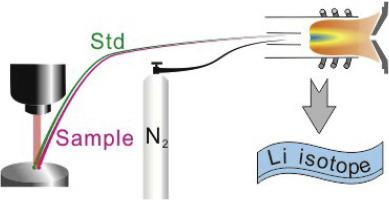Spectrochimica Acta Part B: Atomic Spectroscopy ( IF 3.2 ) Pub Date : 2021-01-21 , DOI: 10.1016/j.sab.2021.106074 Jie Lin , Yongsheng Liu , Lüyun Zhu , Wen Zhang , Zhaochu Hu

|
The accurate calibration of Li isotope ratio analysis was implemented by a simple and easy-to-operate sample-standard bracketing (SSB) calibration method using nanosecond laser ablation multi-collector inductively coupled plasma mass spectrometry (ns-LA-MC-ICP-MS). The method requires stable instrumental conditions to ensure similar or same mass bias for the sample and the bracketing standard. To stabilize the instrumental conditions and reduce the matrix effect, N2 was added at 4 ml min−1 into the central gas, at a cost of 35–42% reduction in intensity of 7Li. Additionally, to reduce the mass bias difference between the sample and the bracketing standard, their positions in the ablation cell and intensity mismatch effect were also evaluated. An offset of up to 5‰ in δ7Li was observed if the sample and standard were too far apart in the laser ablation cell, and our study demonstrated that the position effect was effectively reduced/eliminated when the sample and standard were placed close to each other, or a volume-optional and low-memory (VOLM) cell was applied for analysis. Furthermore, the intensity mismatch effect was evaluated by changing three laser ablation parameters (spot size, energy and repetition rate). To reduce the intensity mismatch effect, Li content of the selected standard should be close to that of sample, and the Li intensity of sample and standard should be matched by adjusting laser repetition rate. According to the investigation of the above influencing factors on the Li isotope ratio measurements, we can optimize an effective analytical scheme of Li isotope for more geological materials using ns-LA-MC-ICP-MS.
中文翻译:

纳秒激光烧蚀多收集器电感耦合等离子体质谱法研究锂同位素分析中氮的添加,位置效应和失配强度效应的研究
通过使用纳秒激光烧蚀多收集器电感耦合等离子体质谱法(ns-LA-MC-ICP-MS)的简单易操作的样品标准包围(SSB)校准方法,实现了Li同位素比分析的准确校准)。该方法需要稳定的仪器条件,以确保样品和包围标准液的质量偏差相似或相同。为了稳定仪器条件和减少基体效应,N 2被以4ml分钟加入-1到中心气体,在成本35-42%的减小的强度7李。另外,为了减少样品和包围标准之间的质量偏差,还评估了它们在消融池中的位置和强度失配效应。向上的偏移至5‰,δ 7如果样品和标准品在激光烧蚀池中的距离太远,则观察到Li的存在,我们的研究表明,当样品和标准品彼此靠近放置时,或体积可选且体积较小时,可以有效地减少/消除位置效应。 -记忆(VOLM)单元格用于分析。此外,通过改变三个激光烧蚀参数(光斑尺寸,能量和重复率)来评估强度失配效应。为减少强度失配效应,所选标准品的Li含量应接近样品的Li含量,并且应通过调整激光重复频率使样品和标准品的Li强度匹配。根据对上述锂同位素比测量的影响因素的调查,











































 京公网安备 11010802027423号
京公网安备 11010802027423号